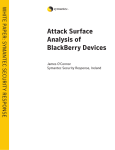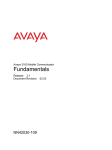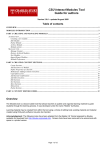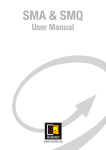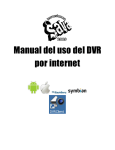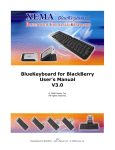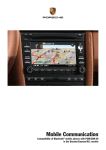Download For Dummies BlackBerry Application Development
Transcript
Chapter 1
RI
AL
Gathering What You Need to
Develop BlackBerry Apps
TE
In This Chapter
▶ Discovering BlackBerry apps and why to develop them
MA
▶ Collecting the right tools
▶ Sharpening the right skills
D
▶ Meeting the challenges of BlackBerry development
TE
A
RI
GH
BlackBerry application is meant to be small, fast, and responsive to
its users. BlackBerry smartphones are small, fast, and function as
mini-communications centers: a phone, text-messaging system, e-mail client,
and Web browser. Your app should give the user the same kind of experience
as the standard apps that come with the BlackBerry, providing information
quickly and easily with a minimal amount of input.
CO
PY
In this chapter, I show you what tools, skills, and ideas you need to gather
and discover to start developing BlackBerry apps.
Why Develop BlackBerry Apps?
The BlackBerry App World from Research In Motion (RIM) provides a marketplace devoted to BlackBerry users, and a great many apps of all different
kinds have yet to be built. BlackBerry devices have been around a while,
mostly as mobile corporate e-mail connections, but the individual consumer
is now getting into BlackBerry devices as well, increasing the number of
places your app can be running. Figure 1-1 shows the Home Screen of my
BlackBerry Curve, with the BlackBerry Browser Application highlighted.
Figure 1-2 shows the Browser while running.
10
Part I: Getting Started on BlackBerry Apps
Figure 1-1:
The
BlackBerry
Curve Home
Screen with
the Browser
application
selected.
Figure 1-2:
The
Browser
application
in action.
Here are a few other reasons why I see the BlackBerry as a great development
opportunity:
✓ BlackBerry applications tend to be small. This makes them easy to
develop and maintain, and they don’t require a large development team:
You need fewer people to debate the pros and cons of different ways to
do the same thing.
✓ BlackBerry apps narrowly focus on delivering what the user wants,
and no more. The apps are simple and direct, providing the user with
only the information they want — and the tools to get it.
✓ BlackBerry apps use Java. You can leverage any desktop PC Java
programming experience you have.
✓ The tools and simulators are all free. You can do all your development
on a Windows PC. The simulators all execute the same code as the
Chapter 1: Gathering What You Need to Develop BlackBerry Apps
actual devices, so you can be sure that if your app works on a simulator,
it will work on a real device.
✓ The BlackBerry is widely used in corporate enterprises. From CEOs to
administrative assistants and everyone in between, you have a market
for business-specific apps that could link everyone in the enterprise.
✓ RIM provides the BlackBerry App World for you to showcase and sell
your app. This venue removes the responsibility of credit card handling,
hosting, downloading, and notifying users of updates. The App World
comes with a variety of pricing tiers, including free and Try & Buy. RIM
keeps 20 percent of your application price to cover some of its costs.
Submitting your app to the App World incurs a $20 fee per submission,
which you can buy in blocks of ten for $200.
Discovering Apps, BlackBerry Style
BlackBerry users are on-the-go, fast-paced, living in the moment, and your
app will need to behave accordingly. BlackBerry users are interested in getting
their information now; they can’t wait more than a few seconds after launching
your app to get to the stuff they expect your app to deliver. Your application
must accommodate your users and provide them with a means of getting
to the value your app adds to their mobile existence. Whether it provides a
world traveler with a list of restaurants open around the clock for the city
they just arrived in, or merely provides a few moments of entertainment
while they’re waiting to board their next flight, your app must be easy to use,
simple to learn — and, as much as possible, fun.
Getting familiar with standard apps
The best way to find out more about BlackBerry applications is, well, to use
them. Look at the apps that run on a BlackBerry out of the box. You can use
a real device or use the BlackBerry simulator that comes with the JDE. Every
BlackBerry comes with the following standard apps:
✓ Browser
✓ Messages (Email and SMS)
✓ Contact Manager
✓ Calendar/Address Book
✓ Memo Pad
✓ Tasks
11
12
Part I: Getting Started on BlackBerry Apps
✓ Calculator
✓ Alarm Clock
Each one of these applications, written by RIM, contains the basic interactions
that BlackBerry users expect to see in your application. BlackBerry users will
be using the standard applications often, and so you should become familiar
with how users get things done with them. Figure 1-3 shows the BlackBerry
Email application as I check my mail account.
Figure 1-3:
The
BlackBerry
Email app.
BlackBerry
Email
lets you
connect to
any e-mail
service
provider,
such as
Gmail.
Understanding how users navigate and
use their BlackBerry smartphones
Most users get most of what they need from a BlackBerry application by
using just one hand, and often, just by using their thumbs on the trackpad (or
trackwheel/trackball for older devices).
The primary input mechanism for a BlackBerry is the pointing device, which
can take one of several forms, depending on which model BlackBerry your
user has.
✓ Trackwheel: Users move the wheel on the side of the BlackBerry
to make the selection highlight move back and forth; users select a
highlighted item by pressing in the trackwheel. Figure 1-4 shows a
BlackBerry 8700 and its trackwheel.
Chapter 1: Gathering What You Need to Develop BlackBerry Apps
Trackwheel
Figure 1-4:
The
BlackBerry
8700
smartphone
provides a
trackwheel.
13
14
Part I: Getting Started on BlackBerry Apps
✓ Trackball: Users can move across the pointer around the two-dimensional
BlackBerry screen; to select a highlighted item, the user clicks the
trackball itself. Figure 1-5 shows a BlackBerry 8830 with its trackball.
Figure 1-5:
The
BlackBerry
8830
smartphone
sports a
trackball for
input.
Trackball
Chapter 1: Gathering What You Need to Develop BlackBerry Apps
✓ Trackpad: Users touch the pad lightly to move the selection highlight,
and press down to click. You can see the trackpad of the BlackBerry
Bold (9700) in Figure 1-6.
Trackpad
Figure 1-6:
RIM’s latest
offering: the
BlackBerry
Bold (9700)
and its
trackpad.
✓ Touchscreen: Users touch the screen lightly to move the selection
highlight, and press down slightly to click the item selected. Figure 1-7
shows you what a BlackBerry Storm looks like, with its touchscreen.
Each input mechanism comes with its own advantages and disadvantages, and
this is important when developing your app. You might discover that your app
is easy to use on a touchscreen device, yet difficult to use on a device with a
15
16
Part I: Getting Started on BlackBerry Apps
trackwheel. If so, you might decide to create two versions of your app: one
optimized for use on a BlackBerry Storm, and one for all the other devices.
Keep in mind that you might have to adjust your app based on what type of
pointing device the user’s BlackBerry supports.
Touchscreen
Figure 1-7:
The
BlackBerry
Storm with
its touchscreen.
Although all BlackBerry devices have a keyboard for users to enter text data,
ideally your app should require very little text input. Typing text into a small
BlackBerry keyboard is slower than typing on a full-size laptop or desktop
keyboard. Investigate whether there is another way for users to provide
information.
Chapter 1: Gathering What You Need to Develop BlackBerry Apps
As long as I’m talking about keyboards, there’s one more thing you need to
know. BlackBerry smartphones offer two different types of keyboards for
users:
✓ SureType: You find this keyboard on the BlackBerry Pearl and Pearl
Flip smartphones, as well as a BlackBerry Storm when in portrait mode.
Figure 1-8 shows an image of a Pearl with its keyboard. Because the
keyboard has fewer keys than a normal keyboard, SureType provides
two letters for each key, and the keyboard is laid out like a regular
QWERTY keyboard. SureType attempts to predict what a user is typing
to speed up the entry of data. Some BlackBerry models with SureType
offer a mode called Multitap, where the first tap of a key enters the first
letter for that key, and a quick double-tap enters the second letter for
that key.
Figure 1-8:
The
BlackBerry
Pearl and its
SureType
keyboard,
with its
guesses for
the word I
type.
17
18
Part I: Getting Started on BlackBerry Apps
✓ Full: You find a regular QWERTY keyboard on every other BlackBerry
model, as well as on the BlackBerry Storm when in landscape mode.
This is the keyboard I prefer to use because all the keys represent one
character and I don’t have to press a key twice. Figure 1-9 shows the
BlackBerry Storm in landscape mode with its full QWERTY keyboard on
display.
Figure 1-9:
BlackBerry
Storm
rotated
clockwise
to show
the full
keyboard
on a touchscreen.
Filling Your Toolbox
You are the most important tool in your software development toolkit. Even
when you’re working as part of a team, your expertise is more important
than the other tools you use to create the code. Your skills in using those
tools are what make the tools useful. However, you can’t develop BlackBerry
apps without the right set of software and hardware tools. The following sections describe the software and hardware you need to gather to start creating
BlackBerry apps.
Downloading the software you need
The following are the major software tools you use to create BlackBerry
applications:
✓ The BlackBerry Java Development Environment (JDE): This integrated
development environment is available from RIM. The JDE includes the
editor, debugger, device simulator, and memory viewer. (See Chapter 2
for the details of choosing a JDE version and downloading it to your PC.)
Chapter 1: Gathering What You Need to Develop BlackBerry Apps
✓ The RAPC compiler: This is the compiler and linker used by the JDE to
produce BlackBerry application files. It makes use of the Sun Java
compiler (see the following bullet) to compile your BlackBerry Java
code, and then packages it into a form that can be installed onto a
BlackBerry device. (The acronym RAPC stands for RIM APplication
Compiler, and you don’t need to download it — the RAPC compiler
comes with the BlackBerry JDE.)
✓ The Sun Java compiler: This is the Sun Microsystems Java Standard
Edition (JSE), which must be version 1.5 or later. You can download the
Sun Java compiler from
http://java.sun.com/javase/downloads/index.jsp
I have run into some difficulty using the JDE on 64-bit Windows machines,
including Windows Vista and Windows 7. As of this writing, the RIM JDE
requires a 32-bit operating system (OS), with a 32-bit version of Sun’s Java, in
order to run at all. In addition, there is no Macintosh OSX tool for BlackBerry
development, unless you use a virtualization application (an application that
allows you to run other operating systems within it).
RIM offers a plug-in for the Eclipse development environment. Eclipse is an
open source (free) Java development environment you can download from
www.eclipse.org. This book concentrates on development using the RIM
JDE, but if you’re comfortable using Eclipse, you should definitely investigate
RIM’s plug-in. As of this writing, the current version of BlackBerry Java
Plug-in for Eclipse is 1.1, and makes use of the BlackBerry OS 5.0 APIs.
Information about the RIM Eclipse plugin can be found at
http://na.blackberry.com/eng/developers/devbetasoftware/javaplugin.jsp
Gathering BlackBerry simulators
The BlackBerry JDE comes with several supporting applications to assist you
in developing a quality BlackBerry application. You use smartphone simulators
to execute your app just as if it were running on a real BlackBerry device.
You use the service simulators to represent the real-world services for the
BlackBerry to access the Internet (through your PC) or to simulate sending
and receiving e-mail. You use simulators in your development process to test
your apps before you run them on an actual BlackBerry smartphone. You can
download the smartphone simulators from RIM at the following URL:
http://na.blackberry.com/eng/developers/resources/simulators.jsp
Appendix A contains more information regarding smartphone and service
simulators.
19
20
Part I: Getting Started on BlackBerry Apps
Basically, here are the four types of simulator applications you want to use:
✓ JDE device simulators: These come with the JDE, and you launch them
with your application already installed. Each JDE comes with its own
set of simulated devices, and the newer JDEs have the newest device
types simulated. Read more about the device types per JDE version in
Appendix A.
The smartphone simulators that each JDE includes in its set simulates
a version of the smartphone OS for that particular version of the JDE.
For instance, the BlackBerry JDE 4.5.0 comes with a simulator for a
BlackBerry smartphone 8320, and this smartphone shows that it is
running smartphone OS 4.5.0.44.
✓ Downloaded device simulators: RIM provides new simulators on its
Web site on a regular basis. You can download and install these simulators
for free. RIM updates its JDEs less frequently than it releases new
devices, so check for new simulator downloads, even while you’re in the
middle of developing your app. Figure 1-10 shows my application, The
Word Locker, running on a simulated BlackBerry Curve (8900).
✓ The Mobile Data Service (MDS) simulator: This comes with the JDE.
A BlackBerry device can talk to the Internet only with the help of an
MDS. A real BlackBerry will be associated with either the RIM-hosted
BlackBerry Internet Service (BIS) or a corporate BlackBerry Enterprise
Server (BES). Each of these associations provides MDS services, allowing the device to connect to the Internet. A simulated device can’t connect to a real MDS service, and so the MDS simulator provides Internet
access for device simulators. If your application needs to communicate
using the Internet, you will have to use the MDS simulator while using a
device simulator.
✓ The Email Service Simulator (ESS): This comes with the JDE. BlackBerry
users love their e-mail, and RIM has created an e-mail simulator that can
act as a gateway to a real e-mail server for a BlackBerry device simulator.
The best thing about all these simulators: They’re free!
Building or buying a development
computer
When you’re creating apps for the BlackBerry, your choice of computers
is limited to a PC running Windows — Windows XP, Windows Vista, and
Windows 7 all work with the BlackBerry development tools, but only as long
as they are 32-bit versions (not 64-bit versions). Your choice of programming
languages is limited to Java, version 1.5 or later, again using the 32-bit
version. This pretty much spells out what you need computer-wise to do
BlackBerry development. I’ve worked on several different computers to
Chapter 1: Gathering What You Need to Develop BlackBerry Apps
do BlackBerry development. In general, it’s better to have a fast machine with
lots of RAM, though you certainly don’t need to buy the most expensive new
computer on the market.
Figure 1-10:
A
BlackBerry
smartphone
simulator
running the
application
WordLocker.
Your development machine will need to handle the following tasks when
you’re developing BlackBerry software:
✓ Editing code: Any computer running Windows XP can support the
requirements of the JDE or any other text editor you prefer. Any machine
that can run Windows Vista or Windows 7 is also an appropriate choice.
Because Microsoft is no longer supporting Windows XP, you might want
to use a newer version of Windows. While Windows XP still works well
for developing BlackBerry apps, you should consider the advantages of
using a newer Windows OS such as Windows 7 because keeping XP
running will get more and more difficult as time goes on.
21
22
Part I: Getting Started on BlackBerry Apps
✓ Compiling the code into an application: This is one of the most powerhungry operations you will be performing again and again. Compiling
Java code is very CPU- and memory-intensive, so you want a machine
that has good processor speed, and as much memory as you can give it.
As mentioned previously, only 32-bit versions of Java and the Windows
operating system can be used for BlackBerry development with RIM’s
tools.
✓ Executing and debugging the application using a simulator: The
device simulators are Windows applications that completely mimic
the operations of a real BlackBerry device. The service simulators
provide functionality that you use to enable your simulated BlackBerry
to access the Internet and send or receive e-mail messages. This
requires a machine that has good processor speed and a lot of memory.
A good midrange computer with a large amount of memory, as much as it
can use, will support your needs for BlackBerry application development.
Table 1-1 shows the requirements for a bare-bones development PC and for a
development PC with power to spare.
Table 1-1
Requirements for a Development PC
Equipment
Minimum Requirements
Optimum Requirements
Processor
2.0 GHz processor
3.0 GHz multi-code CPU
RAM
2GB
4GB
Operating system
Windows XP (Service Pack 3)
Windows 7/32-bit
Java version
Java 1.5.0
Java 1.6.0
Network connection
DSL
Cable
Choosing a BlackBerry device
The BlackBerry models available as of this writing are
✓ Bold (9000, 9650, and 9700)
✓ Curve (83xx, 85xx, and 89xx)
✓ Pearl and Pearl Flip (81xx and 82xx)
✓ Storm and Storm2 (95xx)
✓ Tour (9630)
✓ 8800 series
Chapter 1: Gathering What You Need to Develop BlackBerry Apps
These models are available through the major wireless carriers. A particular
model may be exclusive to a particular carrier — for instance, the Storm
and Storm2 devices are currently Verizon-only, whereas the Bold and Curve
devices were originally AT&T-only. AT&T and Verizon strike deals with RIM
to be the sole providers of a particular model, but usually the exclusivity is
time limited. For instance, Verizon and Sprint have been selling models of the
Curve for a couple of years now, after AT&T’s contract with RIM to be the
only provider selling the Curve ended.
There are pretty much just two ways to acquire a BlackBerry:
✓ Purchase one, new or refurbished, from a wireless service provider.
This requires a service contract with the wireless service provider,
which might not fit into your budget.
✓ Buy one used. This way is usually less expensive than buying from a
wireless service provider but comes with its own set of advantages and
disadvantages.
See Appendix B for more information on buying new or used smartphones.
Using Your Programming Skills
You will need some general skills to develop BlackBerry applications:
✓ Java programming: The Java programming language is the development
language for BlackBerry applications. Your source modules must
represent Java classes, which get compiled into Java class files and then
packaged for the BlackBerry device OS to execute.
✓ Debugging: After you code your app, there’s a statistical likelihood that
it won’t be perfect. If you’re lucky, the imperfections will show up rather
quickly and obviously. As you develop more applications, you’ll find that
the obvious and quickly fixed problems happen less often, which leaves
the subtle and more-challenging bugs. Your skills at debugging — looking
at code as it runs, keeping track of what is going right and what is going
wrong, and so on — will play an important part in completing your apps.
✓ Software design patterns: Like with most modern computing platforms,
your app will benefit from using software patterns where appropriate.
You can certainly create a functional and usable BlackBerry application
without relying on any of the canonical design patterns, but applications
that are to have a long-duration existence will require a solid structure
for operation that the use of software patterns will support. The most
obvious is the Model-View-Controller (MVC) pattern, which enforces
the separation of your app into pieces that are easy to manage. (See
Chapter 4 for more information about MVC.)
23
24
Part I: Getting Started on BlackBerry Apps
Java programming for BlackBerry
For BlackBerry development, you should be familiar with Java programming
in general, and you should know the basics of Java syntax. BlackBerry Java
development is somewhat different from desktop PC Java development. The
major difference is BlackBerry Java has a somewhat smaller set of classes
that you can use to develop applications. Several of the basic Java packages
are available:
✓ java.io.*: This package contains the input/output classes you can use
to manage retrieving data from and delivering data to various locations,
such as Web services and data files.
✓ java.lang.*: You will find the familiar Java base classes such as
String in this package.
✓ java.util.*: Some of the classes available in the desktop version of
Java are available here, such as Vector.
Not all the classes available in the JSE version of these packages are available
in the BlackBerry version. For instance, the BlackBerry java.util.* package
consists of only a dozen or so classes and interfaces, whereas the JSE java.
util.* package comes with almost ten times as many.
RIM removed many classes because of size and performance constraints. For
instance, one of the major changes to the Java language was the addition of
generics in version 1.5, for use with collection classes such as Vector (java.
util.Vector). RIM has not implemented generics for use with BlackBerry
development in part because this feature requires a great deal of overhead
(such as OS functionality) that doesn’t provide a dramatic improvement in
the end result in terms of performance.
In addition to these standard Java packages, several of the javax and org
packages are also available:
✓ javax.microedition.*: The Java Micro Edition (JME) packages are
all available for you to use. If you’ve developed a JME application, you
can run it without modification on a BlackBerry.
✓ javax.bluetooth.*: Your application can access the Bluetooth
hardware on a BlackBerry, if it’s available.
✓ javax.xml.*, org.w3c.dom.*, org.xml.*: These packages provide
classes your app can use to read and write blocks of XML data.
RIM provides a fairly rich framework of classes and interfaces that you can
use to make your application do just about anything you need. The RIM
classes fall into the following three categories:
Chapter 1: Gathering What You Need to Develop BlackBerry Apps
✓ Device interactions: Your applications use the classes in this category’s
packages (net.rim.device.*) to perform operations that make use
of the various parts of the BlackBerry device, such as using the smartphone’s GPS or communicating with Bluetooth devices. In addition, the
classes you use to create every visual user interface object can be found
in this category.
✓ BlackBerry application interactions: You can use the classes in this
category (net.rim.blackberry.*) to interact with the standard
BlackBerry applications. For instance, your app can create an e-mail
message and send it, all without the user having to launch the BlackBerry
Mail application.
✓ Plazmic Media Engine: This category (net.rim.plazmic.*) contains
classes your app can use to deliver audio and video content to your users.
Debugging
The BlackBerry development tools come with a source-level debugger.
However, your own skills in debugging Java software are what matter most.
I assume that in your software application development experience, your
apps didn’t always work perfectly. I’m guessing that you’ve presumably spent
time analyzing code to find where the problems were hiding, and ruthlessly
eliminated them. In general, debugging is still something of an art. Sure, tools
can assist with finding the place where code goes wrong, but you still need
creativity and imagination to know where to start looking. Small applications
are usually easy to debug, but when your app has several dozen classes and
interfaces, bugs find more places to hide.
You can find resources online and in print regarding debugging, as well as
techniques and habits that you can use to make your code easier to debug.
I’ve worked on only a few applications where debugging of some sort was
not necessary, and that includes the sample applications I show you in the
chapters that follow. All of them had quirks and gotchas that required
analysis and imagination to overcome.
Using software patterns
The world of software has been around long enough that a lot of the ways to
solve problems have become standardized. You’ll find that using software
patterns can greatly simplify your code. This leads to code that’s easier to
maintain. Patterns tend to be simple and effective, focusing on delivering a
limited set of functionality within your app. A class in your application that
represents a particular software pattern for achieving a particular objective
is straightforward and easy to test.
25
26
Part I: Getting Started on BlackBerry Apps
The simplest example of a software pattern that you might use is one I
employ in a great many of my applications: the Singleton pattern. Only one
instance of a singleton class will exist in an application. Most singleton
classes have the general appearance shown in Listing 1-1.
Listing 1-1: The Smallest Form of a Singleton Pattern, Implemented in Java
public class SingletonClass
{
private static SingletonClass m_instance;
public static SingletonClass getInstance()
{
if (null == m_instance)
{
m_instance = new SingletonClass();
}
return (m_instance);
}
private SingletonClass()
{
// initialization code
}
//
// the remainder of the methods
//
}
Any code that makes use of this SingletonClass will execute Singleton
Class.getInstance(). This method will instantiate (create) and initialize
the solitary instance of this class available for the application the first time
the method is called, and return that instance that time and every subsequent
time the method is called.
Your application can make use of the Singleton pattern when you want to
restrict access to one specific location for information. This pattern comes in
useful for a large number of different parts of an application, such as
✓ User settings: You will normally have only one user of your application,
and so storing that user’s preferences for your application in a
singleton class makes perfect sense.
✓ Resource connections: Access to resources such as a database should
be funneled through one object because opening a connection to a
resource usually requires substantial code execution. Opening the
connection once and maintaining it through your application’s lifetime
incurs less overhead than multiple openings and closings. You can use a
singleton class to ensure that a connection is opened only once.
Chapter 1: Gathering What You Need to Develop BlackBerry Apps
Understanding BlackBerry Application
Development Challenges
If BlackBerry programming were easy, you wouldn’t need this book. So you
need to be prepared for the inevitable difficulties that will appear. Sometimes
these challenges are caused by the BlackBerry device or its OS, and you will
have to “code around” these types of problems. Sometimes you will discover
you have coded yourself into a corner: for example, a particular decision of
how to code something at an earlier moment has forced responsibilities upon
your code further down the development path.
The following sections describe the challenges that you’ll face in writing
BlackBerry applications.
Choosing an OS version
You have to decide what version of the BlackBerry OS your application will
execute on. This is the most significant decision you must make because it
will influence and constrain your application’s capabilities.
RIM produces new BlackBerry devices — and, therefore, new BlackBerry OS
versions — several times per year. In 2009 alone, the following new devices
were released:
✓ Storm2
✓ Bold 9700
✓ Curve 8900
✓ Tour
Each of these devices came with its own new version of the BlackBerry OS.
OS versions are usually represented by four numbers separated with dots,
such as 4.7.0.113. The first two numbers are usually the most important;
they are the major and minor version numbers. The difference in behavior
between OS 4.6.0.49 and OS 4.6.0.75 is likely to be minor although I have
come across times when such a version upgrade has fixed a bug that my
code encountered.
It’s true! Sometimes you will discover that your perfectly debugged and
packaged code comes across a bug in the OS!
The differences between minor OS versions — say, OS 4.6 versus OS 4.7 —
will likely be significant. Of the two just mentioned, OS 4.7 is interesting
because it’s the only OS that runs on the BlackBerry Storm and Storm2
devices. What’s interesting about these devices? Two things:
27
28
Part I: Getting Started on BlackBerry Apps
✓ Storm and Storm2 use the touchscreen as their primary input mechanism.
This permits your app to make use of users sliding their fingers around
the screen, enabling your app to perform some actions more fluidly.
✓ Storm and Storm2 have accelerometers to indicate the orientation of
the display. Your app can take advantage of knowing whether the user
has switched the device’s orientation from portrait (taller than wide) to
landscape (wider than tall). You can see the Storm showing its landscape
mode in Figure 1-9.
Each JDE has a version number as well, and this version number corresponds
to the version number of the OS that you can code for. I can’t stress this fact
enough:
The version of the JDE you choose will limit which devices your app can run on.
For more information about choosing a JDE version, see Chapter 2.
The JDE version is the minimum device OS version that your app will execute
on. Your application’s code will usually be forward compatible: That is, newer
device OS versions will usually execute code created using an earlier JDE
version. This isn’t always true, but it’s a safe bet for the next several subsequent
versions of the OS. This also depends on what BlackBerry classes your app
uses to do its job. A bare-bones minimalist application that does something
simple such as take user text input and store it in memory isn’t likely to run
afoul of changes in the device OS for several versions to come.
RIM releases a device OS about once every year that runs on all of a set of
the currently available devices. As of this writing, a version of OS 5.0 can run
on all the devices that were released in 2009, plus several others that came
out in 2008. Currently, the OS version that runs on the greatest number of
smartphones is OS 4.5.0.
Using version 5.0 of the JDE, you can develop applications that will run on
every device using OS 5.0. This will mean your app can use classes that take
advantage of the features listed above for the Storm series of devices but
still run (without any ill effects) on non-Storm devices. However, because a
non-Storm phone (such as a BlackBerry Pearl Flip) has neither a touchscreen
nor an accelerometer, code written to take advantage of these features won’t
install on the device because the OS won’t know what to do when it comes
across those specific features in your app. However, a Pearl Flip running OS
5.0 will allow code implemented to use those specific features to execute,
although that part of the code will simply do nothing.
The BlackBerry App World, RIM’s online marketplace for BlackBerry applications,
allows you to deploy separate apps that differ only based on which device each
one is intended to run on. RIM recognizes that you want your application to run
on as many different devices as can access the App World, but that you also
want your application to take advantage of the features each device provides,
instead of just coding to one common-denominator, lower-level device OS.
Chapter 1: Gathering What You Need to Develop BlackBerry Apps
Thus, your application can exist in the App World in multiple forms. For
example, if you intend for your app to be used only by those users who have
accelerometers in their BlackBerry devices, you can restrict your app to an
OS 4.7-only zone, and no other device will be able to install it. Note: If you
want your app to run on all devices but also take advantage of accelerometers
when running on a Storm, you have to develop two versions of your app: one
for Storm devices and then one for all the rest.
The key point is that these two different applications only constitute one
app submission to the App World, so you’re only paying for one submission
instead of two. Chapter 12 goes over the details you need to know about the
App World, and your app’s life there.
Programming defensively
Your application hopefully will be used by tens of thousands of people
worldwide. When that happens, each user becomes a stress test for your
app. These users will inadvertently discover ways of breaking your
application — causing unforeseen consequences to occur — that you never
thought of. Your users will be your next major challenge.
Users follow a bell curve in terms of their use of your app. Most will behave
exactly as you expect, following a “happy path” of operation where they
never encounter shortcomings in your app and never try to make the app
do something incorrect. But a small faction of users either intentionally or
unintentionally drives your app into a situation it’s not prepared to handle. If
you’re working for a large organization with a Quality Assurance department,
a great many of these situations can be discovered and resolved before your
code hits the outside world. If you’re a solo entrepreneur, the burden falls on
your shoulders.
Most abnormal situations are a result of invalid user input. This specific cause
can be eliminated through the use of fixed-input entry fields: UI elements that
restrict user input to particular data types or specific values. In addition, your
app should “sanitize” the data that users can provide as input, to make sure
that nothing bad gets inside your app to wreak havoc.
For instance, your app may want users to enter a date value, perhaps for a
birthday reminder. You could use a simple text-editing component, such as
an EditField, for users to select and start typing in a date. But you would
then have to make sure that what they enter is actually a real date — this
could be any of the following:
✓ 09/01/10
✓ September 1, 2010
✓ 2010-09-01
29
30
Part I: Getting Started on BlackBerry Apps
As you can see, letting users enter arbitrary text data forces you to implement
the appropriate conversion method for turning their entries into a form more
suitable for your app to make comparisons and calculations with. However,
a basic text-entry field also allows your users to enter text such as Karl’s
Birthday just as easily.
This text will pretty much crash your application if it tries to add or subtract
days, months, or years to or from it. A better way to ensure that only valid
date values, easily converted to a usable form, are entered is to use UI
components that limit what a user is permitted to enter. In this case, using a
component such as a DateField would be much more appropriate. Unless
you want to give your users more flexibility — which forces you to convert
every possible input to an appropriate, usable form within your app.
Another potential cause of problems is users who download a version of your
app that is not valid for their smartphone OS. Luckily, the BlackBerry App
World gives you the ability to provide multiple versions of your application
customized to the different smartphones that RIM supports. You discover all
this in Chapter 12.
Entering a Brave, New
BlackBerry App World
With the success of the Apple App Store for delivering software to iPhone
devices, major smartphone manufacturers and even some wireless service
providers are designing and deploying their own storefronts to sell applications
designed for their platforms. As mentioned earlier, RIM hosts the BlackBerry
App World, which is an online marketplace for all kinds of BlackBerry
applications. The App World provides many categories of applications for
BlackBerry users to download, such as Business, Education, Games, News,
Shopping, and Utilities. (For the complete list, see Chapter 12).
Each category is further subdivided, allowing prospective buyers to drill
down through the store and find the app that’s right for them. You, as a
developer, should become familiar with the user’s experience of searching
and finding apps in the BlackBerry App World, to place your app in the right
category and to make sure your app shows off its best face. You find out
about all the App World categories and their subcategories in Chapter 12.
Deciding what kind of app to create
If you already have an idea for an app, great! You’ve passed one of the most
difficult steps on your way to BlackBerry App World riches! Figuring out what
Chapter 1: Gathering What You Need to Develop BlackBerry Apps
you want to develop can be challenging, so I recommend that you review the
apps available in the App World in a variety of different categories. Think of
this exercise as window shopping. Your imagination will be working in the
background while you look at what’s for sale already, and all it takes is one
example to trigger something wonderful.
Brainstorming, alone or in groups
I am a co-founder of a small startup, BlazingApps. The other co-founders and
I sit down irregularly for a brainstorming session. We go around the table
and contribute an idea or many about different apps we’ve thought about
since the previous meeting. I enjoy this kind of imaginative collaboration and
highly recommend it. Granted, you might find it difficult to brainstorm all
by yourself, so for the solo entrepreneur, I highly recommend writing down
any thoughts or ideas somewhere so that you can easily find them again.
You should write down everything, no matter how small or unimportant you
might think it is. This way, you’ll have a collection of thoughts and imaginings
that you can use to spark more of the same. Or else, some combination of
your thoughts and imaginings across a spectrum of your recorded notes will
group together and prove to be an app worth creating.
How one idea leads to another
For instance, in a project on another
smartphone device, I once had a need to d
isplay text in a variety of the available fonts to
demonstrate to the user experience specialist
what the device’s different fonts would look
like. Several apps were available at this
platform’s marketplace to do this, and even
writing my own was fairly straightforward.
But it got me thinking: The fundamental problem
I was trying to solve was an inability on the part
of the development team to quickly and clearly
see what the results of our choices for user
interface elements would actually end up looking
like. There was no way for the user experience
specialist to “play around” with different
settings and get an instant reaction to the
settings on a real device.
Unless. . . . What if I created an app that allowed
a user of the smartphone to mix and match
fonts and buttons and labels and menus and all
the other user interface objects on the phone
itself? In essence, this would be an “interface
creator” application, running on the actual
device, so that anyone with a device could “try
out” different combinations of user interface
items. Developing such an application would
be helpful to anyone in an organization who
wants to prototype user interface development,
without actually having to write code.
This is the kind of imagination-behind-thescenes that can lead to applications that your
users will want to use. I haven’t gone out to
build this particular app, yet, but you have my
permission to make the attempt.
31
32
Part I: Getting Started on BlackBerry Apps
Even if you’re a solo entrepreneur, talking with other developers or even
just acquaintances can generate ideas. You can scan the BlackBerry online
forums to pick up what issues users are running into and develop ideas based
on problems they are encountering and — obviously — want a solution for.
Becoming a BlackBerry developer and
App World vendor
Your first step toward BlackBerry app development is to register with RIM as
a BlackBerry developer. You then gain access to a treasure trove of all things
BlackBerry, including
✓ All BlackBerry JDE downloads
✓ All BlackBerry simulator downloads
✓ Articles pertaining to BlackBerry development (the Knowledge Base)
✓ The official BlackBerry online development forums
✓ All developer documentation
The developer registration process is pretty straightforward. I go over the
steps involved in Chapter 2.
Becoming a BlackBerry App World vendor is a little more complicated, with
more steps to follow because (you guessed it) money is involved. You need a
PayPal account. I go over these details as well in Chapter 2.

























